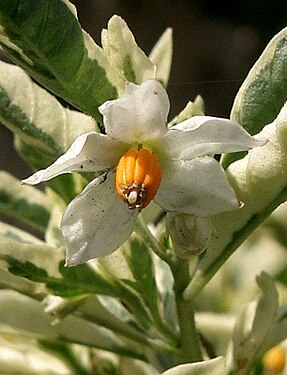Solanum pseudocapsicum
| Habit | shrub
| |
|---|---|---|
| Height: | ⇕ | 3 ft"ft" can not be assigned to a declared number type with value 3. to 6 ft"ft" can not be assigned to a declared number type with value 6. |
| Width: | ⇔ | 4 ft"ft" can not be assigned to a declared number type with value 4. |
| Lifespan: | ⌛ | perennial |
| Exposure: | ☼ | sun |
|---|---|---|
| Features: | ✓ | evergreen |
| USDA Zones: | 9 to 11 | |
| Flower features: | ❀ | white |
|
Solanum > |
The Jerusalem Cherry or Madeira Winter Cherry (sometimes just, ambiguously, "winter cherry"), Solanum pseudocapsicum, is a nightshade species with poisonous fruit. These perennials can be grown decoratively as a house plant, but in some areas of Australia the plant has become a weed.
The plant is perennial in zones up to USDA 8. Native to Peru, they can survive frosts and cold weather. They generally live up to 10 years, producing fruit usually in their 2nd or 3rd year, and every year after that. They are congeners of tomatoes and the fruit is extremely similar to cherry tomatoes in taste and texture, and are therefore easily confused with them.
The Jerusalem Cherry's poison is primarily solanocapsine, which is similar to other alkaloids found in their genus, such as solanine and atropine. Although the toxin is poisonous, it is generally not life-threatening. It may cause gastric problems, including vomiting and gastroenteritis as referenced in the obsolete scientific name S. ipecacuanha (roughly "ipecac nightshade").[1]
Cultivation
Propagation
Pests and diseases
Varieties
Supposedly, the plant described as Solanum capsicastrum and called False Jerusalem Cherry is closely related but distinct species, and the trade name "Winter Cherry" is also held to apply to this exclusively. It is said to be recognizable by more mediocre size, and/or a greyish hue to the foilage and/or stems, and/or fruit that have a pronounced yellow hue when unripe and whose pulp is not or less poisonous (though the seeds still are, making the whole fruit still inedible), and/or higher frost hardiness. But these supposed differences are inconsistently given in various horticultural sources, and no botanical source has in recent times distinguished between the two. Indeed, these taxa are now generally held to refer to the same species, and the "False Jerusalem Cherry", if it is at all distinguishable, seems to be a chemotype at best, or just a motley collection of cultivars.[2]
Gallery
References
External links
- w:Solanum pseudocapsicum. Some of the material on this page may be from Wikipedia, under the Creative Commons license.
- Solanum pseudocapsicum QR Code (Size 50, 100, 200, 500)



